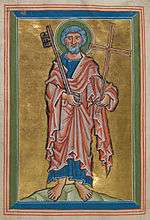Archimandrite
The title archimandrite (Greek: ἀρχιμανδρίτης archimandritis), primarily used in the Eastern Orthodox and the Eastern Catholic churches, originally referred to a superior abbot whom a bishop appointed to supervise several 'ordinary' abbots (each styled hegumenos) and monasteries, or to the abbot of some especially great and important monastery.
It is also used as one purely title of honour, with no connection to any actual monastery, and is bestowed on clergy as a mark of respect or gratitude for service to the Church. This particular sign of respect is only given to those priests who have taken vows of celibacy, that is monks. Distinguished married clergy may receive the title of archpriest.
History
The term derives from the Greek: the first element from ἀρχι archi- meaning "highest" or from archon "ruler"; and the second root from μάνδρα mandra meaning "enclosure" or "corral", "pen" and denoting a "monastery" (compare the usage of "flock" for "congregation").
The title has been in common use since the 5th century, but is mentioned for the first time in a letter to Epiphanius, prefixed to his Panarium (ca. 375), but the Lausiac History of Palladius may evidence its common use in the 4th century as applied to Saint Pachomius.
When the supervision of monasteries passed to another episcopal official—the Great Sakellarios ("sacristan")—the title of archimandrite became an honorary one for abbots of important monasteries (compared to an ordinary abbot, a hegumenos).
Kiev Metropolis
Initially in some cases it served as an extra title: for example, manuscripts of 1174 mention Hegumen Polikarp of Kiev Cave Monastery as "Hegumen Archimandrite".
Russian usage
.jpg)
In 1764 the Russian Orthodox Church secularised its monasteries and ranked them in one of three classes, awarding only the abbots at the head of monasteries of the second or first class the title of archimandrite. Abbots of third class monasteries were to be styled "hegumen".
The duties of both a hegumen and an archimandrite are the same; however, during the Divine Service a hegumen wears a simple mantle, while the mantle of an archimandrite is decorated with sacral texts; an archimandrite also wears a mitre and bears a pastoral staff (pateritsa).
The Russian Orthodox Church commonly selects its bishops from the ranks of the archimandrites.
Greek usage
An archimandrite is a priest who has taken monastic vows and is theoretically in line to be ordained a bishop. Churches under the spiritual jurisdiction of the four Eastern Orthodox Patriarchates generally require that such a monastic priest possess a university degree in theology before they are elevated to the rank of archimandrite. Sometimes the requirement is waived if the priest can show outstanding achievement in other academic fields, such as the humanities or science.
Western usage
| Part of a series on the |
| Hierarchy of the Catholic Church |
|---|
 |
| Ecclesiastical titles |
|
|
Liturgical titles |
|
Administrative and pastoral titles
|
|
Consecrated and professed titles |
|
|
An archimandrite who does not function as an abbot has the style "The Very Reverend Archimandrite" whilst one with abbatial duties uses the style "The Right Reverend Archimandrite".
The word occurs in the Regula Columbani (c. 7), and du Cange gives a few other cases of its use in Latin documents, but it never came into vogue in the West; yet, owing to intercourse with Greek and Slavonic Christianity, the title sometimes appears in southern Italy and Sicily, and in Croatia, Hungary and Poland.
References
-
 This article incorporates text from a publication now in the public domain: Chisholm, Hugh, ed. (1911). "Archimandrite". Encyclopædia Britannica (11th ed.). Cambridge University Press.
This article incorporates text from a publication now in the public domain: Chisholm, Hugh, ed. (1911). "Archimandrite". Encyclopædia Britannica (11th ed.). Cambridge University Press. - This article incorporates material from the public domain 1906 Brockhaus and Efron Encyclopedic Dictionary.
- Dictionnaire d'archéologie chrétienne et de liturgie (in French)
Further reading
- Plank, Peter (1999), "Archimandrite", in Fahlbusch, Erwin, Encyclopedia of Christianity, 1, Grand Rapids: Wm. B. Eerdmans, p. 118, ISBN 0802824137
External links
 The dictionary definition of archimandrite at Wiktionary
The dictionary definition of archimandrite at Wiktionary